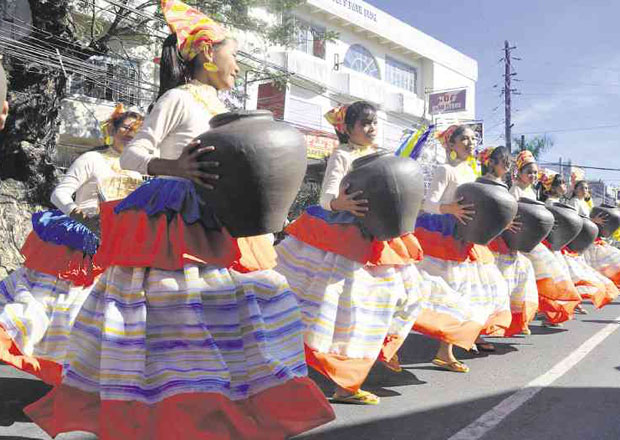‘Bagoong’ makes Lingayen townsfolk dance

‘BAGOONG’ FESTIVAL. Students carrying earthen jars used to store “bagoong” (salted fish paste) dance in the streets of Lingayen town, Pangasinan province, during the Bagoong Festival featuring the capital town’s main product. WILLIE LOMIBAO/CONTRIBUTOR
LINGAYEN, Pangasinan—It’s not every day when one can say “bagoong” (salted fish paste) has made Lingayen dance.
Residents of this capital town partied on the streets on Thursday to celebrate its third Bagoong Festival.
The event was launched during the time of the late Mayor Jonas Castañeda to promote the town’s prime product and tell the world that Lingayen is the home of the most delectable bagoong, said Sunshine Robles, municipal information officer.
Bagoong, which is produced in two coastal villages here, is one of the town’s thriving industries. Lingayen has 56 bagoong processors, wholesalers and retailers, according to the Department of Trade and Industry provincial office in Dagupan City.
Each manufacturing firm is a medium-sized enterprise, employing 50 to 100 workers, with capital ranging from P15 million to P100 million. Each produces at least 1,500 boxes of bagoong in big and small bottles every month.
Article continues after this advertisementA bagoong maker in the area has been exporting its products to California and Hawaii in the United States.
Article continues after this advertisementDaniel Bernal Jr., proprietor of JB Bagoong, one of the town’s biggest bagoong makers, said he had convinced officials of Barangay (village) Pangapisan Norte to organize the festival in 2011. “I told them, ‘Why don’t we also make noise? If other towns can hold festivals for their products, why can’t we?’” Bernal said.
The first Bagoong Festival was held in April 2011 in Pangapisan Norte. It was joined by the neighboring village of Maniboc, another bagoong producer.
The festival was eventually moved to January as part of Lingayen’s fiesta celebration in honor of its patron.
“This is also our way of thanking God for the success of the bagoong industry. This has been the source of livelihood of many people here,” Bernal said.
He said it was his father, Daniel Bernal Sr., who began bagoong making in his community. “My father was a fisherman who sold fish in the market [and peddled his catch] from one house to another,” he said.
“One time, he put all the unsold fish in one jar [filled with] salt so he could [preserve them for frying]. Unfortunately, he forgot about [the jar] and when he saw it again after several weeks, all of the fish [had] decomposed. But [the jar’s contents] smelled and tasted good,” he said.
That was his first set of bagoong, which has since become a popular ingredient in the everyday cooking of Filipino dishes.
“We are blessed. Our sales continue to improve and we have also continued to improve our product,” Bernal said. Now, bagoong is sold in bottles.